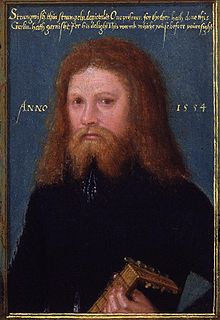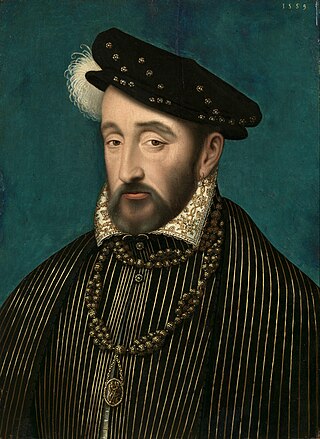
Henry II was King of France from 1547 until his death in 1559. The second son of Francis I and Duchess Claude of Brittany, he became Dauphin of France upon the death of his elder brother Francis in 1536.

Francis Russell, 2nd Earl of Bedford, KG of Chenies in Buckinghamshire and of Bedford House in Exeter, Devon, was an English nobleman, soldier, and politician. He was a godfather to the Devon-born sailor Sir Francis Drake. He served as Lord Lieutenant of Devon (1584-5).
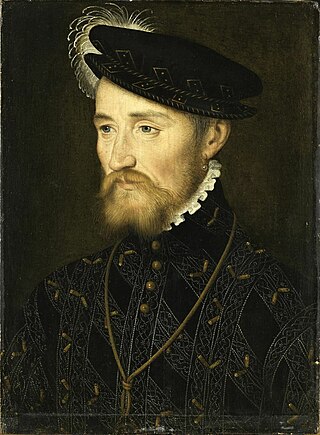
François de Lorraine, 2nd Duke of Guise, 1st Prince of Joinville, and 1st Duke of Aumale, was a French general and statesman. A prominent leader during the Italian War of 1551–1559 and French Wars of Religion, he was assassinated during the siege of Orleans in 1563.
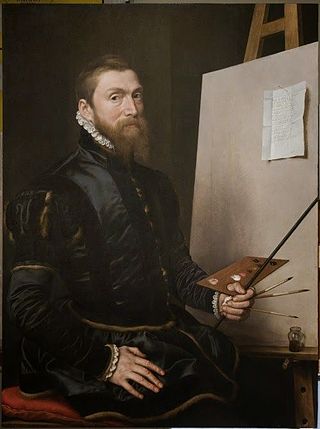
Anthonis Mor, also known as Anthonis Mor van Dashorst and Antonio Moro, was a Netherlandish portrait painter, much in demand by the courts of Europe. He has also been referred to as Antoon, Anthonius, Anthonis or Mor van Dashorst, and as Antonio Moro, António Mouro, Anthony More, etc., but signed most of his portraits as Anthonis Mor.

Henry Constable was an English poet, known particularly for Diana, one of the first English sonnet sequences. In 1591 he converted to Catholicism, and lived in exile on the continent for some years. He returned to England at the accession of King James, but was soon a prisoner in the Tower and in the Fleet. He died an exile at Liège in 1613.
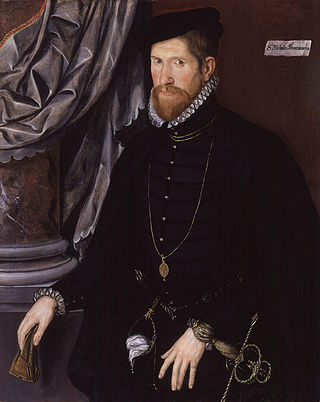
Sir Nicholas Throckmorton was an English diplomat and politician, who was an ambassador to France and later Scotland, and played a key role in the relationship between Elizabeth I of England and Mary, Queen of Scots.
Sir James Croft PC was an English politician, who was Lord Deputy of Ireland, and MP for Herefordshire in the Parliament of England.

Margaret Stanley, Countess of Derby was the only surviving daughter of Henry Clifford, 2nd Earl of Cumberland and Lady Eleanor Brandon. Her maternal grandparents were Charles Brandon, 1st Duke of Suffolk and Mary Tudor, Queen of France. Mary was the third daughter of King Henry VII of England and Elizabeth of York.

James Pilkington (1520–1576), was the first Protestant Bishop of Durham from 1561 until his death in 1576. He founded Rivington Grammar School and was an Elizabethan author and orator.

The artists of the Tudor court are the painters and limners engaged by the monarchs of England's Tudor dynasty and their courtiers between 1485 and 1603, from the reign of Henry VII to the death of Elizabeth I.

Sir John Thynne was the steward to Edward Seymour, 1st Duke of Somerset, and a member of parliament. He was the builder of Longleat House, and his descendants became Marquesses of Bath.
Events from the year 1554 in art.

Sir Edward Rogers was an English gentleman who served as an Officer of State in various capacities during the Tudor period. He rose to become Comptroller and Vice-Chamberlain of the Household to Elizabeth I of England from 1560 to 1568.

Gerlach Flicke, Latin name Gerbarus Fleccius, anglicised in the 16th century as "Garlicke", was a German portrait painter who is known for his work in London as an artist of the Tudor court. Flicke was imprisoned in London and he made a portrait miniature whilst there. This painting is the earliest self-portrait in oils made in England.
John Véron was a French Protestant controversialist and preacher, known for his activities in England. Véron also served as an English translator for the English Privy Council.
Sir Thomas Copley (1534–1584) was a prominent English Roman Catholic politician and exile of the reign of Elizabeth I. Knighted, perhaps by the king of France, and created ennobled by Philip II of Spain, he was often known by contemporaries as "Lord Copley".

Sir Giles Strangways, of Melbury Sampford, Dorset, was five times MP for Dorset in 1553, 1554, 1555, 1558 and 1559.

The Flying Gang was an 18th-century group of pirates who established themselves in Nassau, New Providence in the Bahamas after the destruction of Port Royal in Jamaica. The gang consisted of the most notorious and cunning pirates of the time, and they terrorized and pillaged the Caribbean until the Royal Navy and infighting brought them to justice. They achieved great fame and wealth by raiding salvagers attempting to recover gold from the sunken Spanish treasure fleet. They established their own codes and governed themselves independent from any of the colonial powers of the time. Nassau was deemed the Republic of Pirates as it attracted many former privateers looking for work to its shores. The Governor of Bermuda stated that there were over 1,000 pirates in Nassau at that time and that they outnumbered the mere hundred inhabitants in the town.

The Proclamation for Suppressing of Pirates was a royal proclamation issued by George I of Great Britain on 5 September 1717. It promised a pardon for acts of piracy committed before the following 5 January to those pirates who surrendered themselves to the correct authority before a deadline. Originally, the surrender had to occur on or before 5 September 1718; this was later extended by a second proclamation to 1 July 1719.

Acts of grace, in the context of piracy, were state proclamations offering pardons for acts of piracy. General pardons for piracy were offered on numerous occasions and by multiple states, for instance by the Kingdom of England and its successor, the Kingdom of Great Britain, in the 17th and 18th centuries.
